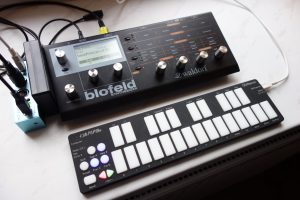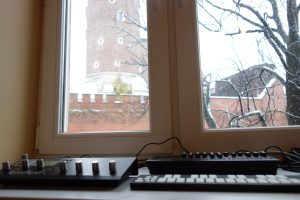Waldorf Blofeld Multimode
I have many plans for live performances, but my current studio rig is too bulky to move around easily and requires a power outlet, neither of which is good for on-the-go performing. So I found a battery with both 12V & 5V DC outputs for the Blofeld and my other USB-powered gear, and then connected a speaker directly to the final synthesizer’s output. The Blofeld does not draw much current, so a small battery like this will power the whole rig for two hours or more. Short of an iPad or laptop, I think this is about as small as you can get and still have something approaching the abilities of a full studio while not limiting in any way where you can create or perform, and all on a rechargeable battery!
You might notice one omission here: there is no external sequencer present, just a keyboard controller. Instead, I plan to use Blofeld’s License SL and its extensive arpeggiator features to bypass the need for a sequencer and sampler. Shuffle and other parameters of the arpeggiator should enable me to create nearly any pattern, and with clever modulation, the variations for those patterns can be virtually endless. In this blog I’ll share what I’ve learned about multimode, and in a future one, I’ll get into the arp and sampling sections. A table with the relevant multimode parameters for my configuration is below, and below that are some tips that I hope will help you if you’re just getting started.
Dope Robot 2nd Test Multi
| Part # / Ch. | Key Range | Instrument | Arp Timing | Notes |
|---|---|---|---|---|
| 01 | F#2 - D#3 | arp bass | 1/8 | main Effect 2 settings |
| 02 | C2-C2 | kick | 1/4 | alt kick arp @ C#2 |
| 03 | D2-D2 | snare | 1/2 | alt snare arp @ D#2 |
| 04 | E2-E2 | closed hihat | 1/8 | map LPF to CC |
| 05 | F2-F2 | clap | 1/2 | |
| 06 | D3-F6 | high keys | internal or external (JX-03) |
Multimode Notes
- The arp tempo knobs have no effect in multimode, which was sort of weird, because they are available to edit, so the number would be changing, but the sound didn’t. But as the manual says, globaI tempo in multimode “affects all arpeggiators, all LFO and all Effects and overrides the corresponding sound tempo settings.”
- Effect 2 is a global effect for the entire multi, and it is always on Part 1, so if you want to use reverb or delay on any sequence, you need to set up Part 1 accordingly. You can even change the Effect 2 parameters of other programs in multimode, but if you don’t save it to the Part 1 slot, it will not be saved when you return.
- Effect 1 is available for Parts 1-4, but its parameters are still stored in the
sound program, including mix level. Parts 5-16 have no Effect 1, so if your sound program depends significantly on Effect 1, place it into Part 1-4. A reminder:
- Effect 1: Chorus, Flanger, Phaser, Overdrive, Triple FX (S&H/Overdrive/Chorus)
- Effect 2: everything in Effect 1 + Delay, Clocked Delay, Reverb
- Multimode is the only area where you can filter incoming or outgoing midi data like program change, control change, etc. There is no global location for these settings.
- Be careful that the key ranges you have set up on the Blofeld match the key ranges set up on your controller keyboard.
Now that I have a proof of concept I can transition to using the extensive modulation options of the Blofeld and QuNexus to design patches that will make a live performance inspiring, engaging and fun. If there are any errors or you have any feedback, feel free to leave a comment. Thanks and good luck!




